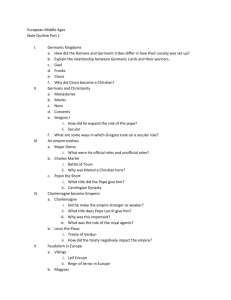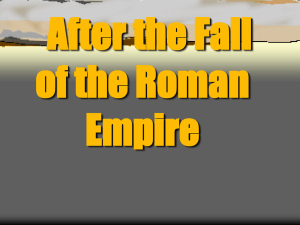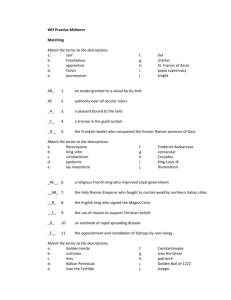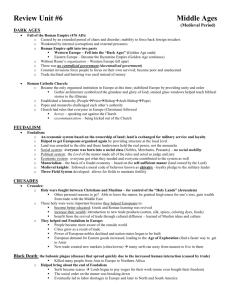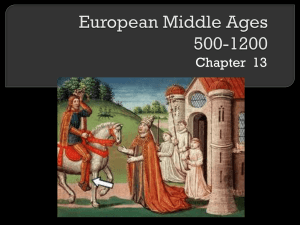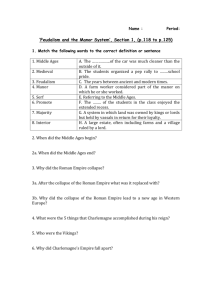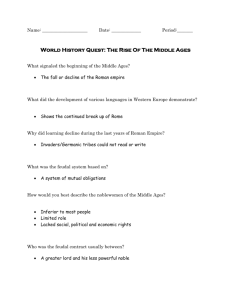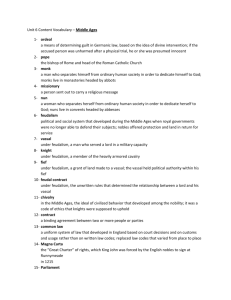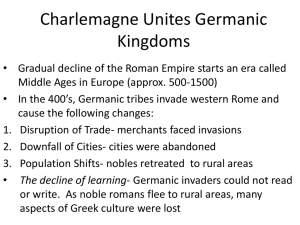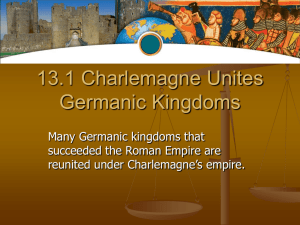Chapter 13 Review: European Middle Ages 500
advertisement
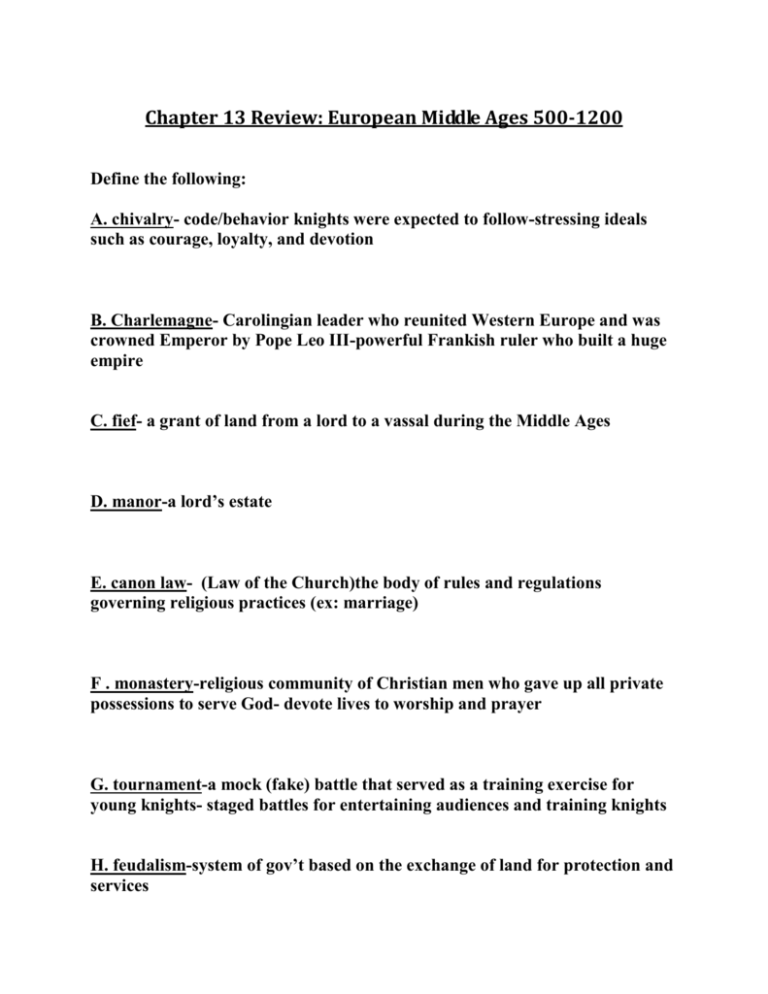
Chapter 13 Review: European Middle Ages 500-1200 Define the following: A. chivalry- code/behavior knights were expected to follow-stressing ideals such as courage, loyalty, and devotion B. Charlemagne- Carolingian leader who reunited Western Europe and was crowned Emperor by Pope Leo III-powerful Frankish ruler who built a huge empire C. fief- a grant of land from a lord to a vassal during the Middle Ages D. manor-a lord’s estate E. canon law- (Law of the Church)the body of rules and regulations governing religious practices (ex: marriage) F . monastery-religious community of Christian men who gave up all private possessions to serve God- devote lives to worship and prayer G. tournament-a mock (fake) battle that served as a training exercise for young knights- staged battles for entertaining audiences and training knights H. feudalism-system of gov’t based on the exchange of land for protection and services I . excommunication- the act of taking away a person’s right to membership in the Church- banished from the Church J. Charles Martel-leader halted/stopped the Muslim invasion of Western Europe at the Battle of Tours- made him a Christian hero Review Questions: 1. The achievement for which Charlemagne is most remembered was Building an empire larger than any since Rome 2. What is true about Germanic tribes? They lived in small, closely knit communities, had strong tradition of songs and legends, and each tribe’s chief had a group of warriors loyal only to him 3. According to the code of chivalry, a knight fought for what? His lady, feudal lord, and his heavenly lord 4. Viking raids eventually ceased because of several factors, including the fact that Farming conditions in the Viking homeland improved 5. The Treaty of Verdun resulted in The division of Charlemagne’s empire into three parts 6. The bargain made between a lord and a vassal was The lord would defend the vassal in battle 7. Eleanor of Aquitane achieved her fame in part because she Was the queen of England 8. The interdict was an effective weapon for a pope to use against a king because It cost the king the loyalty of his subjects, who feared for their own souls 9. Pope Gregory VII and the German emperor Henry IV fought over the issue of Secular appointment of bishops 10.The main difference between the original Roman Empire and the Holy Roman Empire of Frederick I was that Frederick’s empire had no strong central gov’t 11.What did the development of various languages in Western Europe demonstrate? It mirrored the continued breakup of the Roman Empire 12.Why did learning decline during the last years of Roman Empire? Invaders could neither read nor write and did not understand Latin 13.Why did Henry IV stand barefoot in the snow for three days begging forgiveness of Pope Gregory VII? The bishops whom Henry had appointed switched allegiance to the pope 14.The Concordat of Worms resolved a power struggle between which two groups? The Church and the Holy Roman emperor 15.What was the significance of Pope Leo III crowning Charlemagne emperor? It joined Germanic power with the Church and the heritage of Rome 16.What were the forces holding feudal society together? A set of mutual social obligations and the teachings of the Church 17.What led to the development of the code of chivalry? The constant, brutal fighting among nobles Answer the following questions in essay form. 18. Recognizing Effects: How did Germanic invasions lead to feudalism in Europe? The repeated invasions disrupted trade, which meant that European cities no longer functioned as economic centers. The invasions destroyed the Roman Empire, eliminating the need for cities as administrative centers. People threatened by invaders moved to rural areas where they could grow their own food. The need for protection from invaders and from each other made peasants willing to give up certain freedoms for the protection offered by a lord. The need for land to grow crops for survival led peasants to accept the conditions of life on a manor. It was traditional among Germanic peoples to be loyal to known leaders but not to unknown public administrators or governors. It was traditional among Germanic peoples to live in small communities. 19.Synthesizing : How was medieval European society organized socially, economically, militarily, and religiously? How did the various systems support and reinforce each other? Feudalism developed in response to foreign invasions during the early Middle Ages. People needed protection from invading tribes that plundered communities. As part of achieving peace, rulers and warriors made pacts of loyalty to each other. A king or lord gave his warriors or nobles (vassals) a plot of land (fief) in exchange for protection. This bond evolved into a complicated system of mutual obligations. Supporting feudalism was the manor system, an economic arrangement. A manor was a lord's estate. Peasants (serfs) worked the land in exchange for protection and a place to live. Their life was hard and limited. While feudalism divided people into social classes, the Church became a unifying force. Because feudal Europe had a weak central government, the Church filled the gap. Each manor had clergy, and the Pope ruled from Rome, using the power to excommunicate, for example, to control rulers. The Church became so powerful, kings and lords had to negotiate their relationships with high church officials. During this time, monasteries became the center of learning and education. They, too, added strength to the Church's power. Finally, the Church taught people to accept the hardship of life in the hopes of heavenly reward. This helped prevent serfs from questioning their status.
